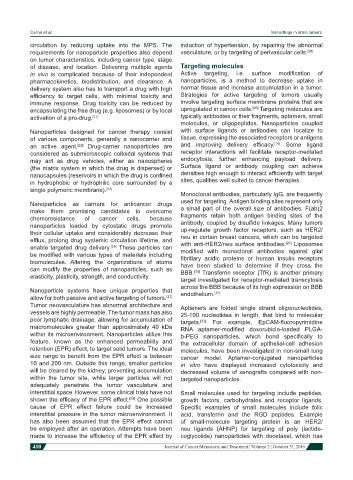Page 420 - Read Online
P. 420
Cerna et al. Nanodrugs in brain tumors
circulation by reducing uptake into the MPS. The induction of hypertension, by repairing the abnormal
requirements for nanoparticle properties also depend vasculature, or by targeting of perivascular cells. [28]
on tumor characteristics, including cancer type, stage
of disease, and location. Delivering multiple agents Targeting molecules
in vivo is complicated because of their independent Active targeting, i.e. surface modification of
pharmacokinetics, biodistribution, and clearance. A nanoparticles, is a method to decrease uptake in
delivery system also has to transport a drug with high normal tissue and increase accumulation in a tumor.
efficiency to target cells, with minimal toxicity and Strategies for active targeting of tumors usually
immune response. Drug toxicity can be reduced by involve targeting surface membrane proteins that are
[25]
encapsulating the free drug (e.g. liposomes) or by local upregulated in cancer cells. Targeting molecules are
activation of a pro-drug. [21] typically antibodies or their fragments, aptamers, small
molecules, or oligopeptides. Nanoparticles coupled
Nanoparticles designed for cancer therapy consist with surface ligands or antibodies can localize to
of various components, generally a nanocarrier and tissue, expressing the associated receptors or antigens
[10]
an active agent. Drug-carrier nanoparticles are and improving delivery efficacy. Some ligand
[22]
considered as submicroscopic colloidal systems that receptor interactions will facilitate receptor-mediated
may act as drug vehicles, either as nanospheres endocytosis, further enhancing payload delivery.
(the matrix system in which the drug is dispersed) or Surface ligand or antibody coupling can achieve
nanocapsules (reservoirs in which the drug is confined densities high enough to interact efficiently with target
in hydrophobic or hydrophilic core surrounded by a sites, qualities well suited to cancer therapies.
single polymeric membrane). [23]
Monoclonal antibodies, particularly IgG, are frequently
Nanoparticles as carriers for anticancer drugs used for targeting. Antigen binding sites represent only
make them promising candidates to overcome a small part of the overall size of antibodies. F(ab)2
chemoresistance of cancer cells, because fragments retain both antigen binding sites of the
nanoparticles loaded by cytostatic drugs promote antibody, coupled by disulfide linkages. Many tumors
their cellular uptake and considerably decrease their up-regulate growth factor receptors, such as HER2/
neu in certain breast cancers, which can be targeted
efflux, prolong drug systemic circulation lifetime, and with anti-HER2/neu surface antibodies. Liposomes
[29]
enable targeted drug delivery. These particles can modified with monoclonal antibodies against glial
[26]
be modified with various types of materials including fibrillary acidic proteins or human insulin receptors
biomolecules. Altering the organizations of atoms have been studied to determine if they cross the
can modify the properties of nanoparticles, such as BBB. Transferrin receptor (TfR) is another primary
[30]
elasticity, plasticity, strength, and conductivity. target investigated for receptor-mediated transcytosis
across the BBB because of its high expression on BBB
Nanoparticle systems have unique properties that endothelium. [31]
allow for both passive and active targeting of tumors.
[27]
Tumor neovasculature has abnormal architecture and Aptamers are folded single strand oligonucleotides,
vessels are highly permeable. The tumor mass has also 25-100 nucleotides in length, that bind to molecular
poor lymphatic drainage, allowing for accumulation of targets. For example, EpCAM-fluoropyrimidine
[32]
macromolecules greater than approximately 40 kDa RNA aptamer-modified doxorubicin-loaded PLGA-
within its microenvironment. Nanoparticles utilize this b-PEG nanoparticles, which bond specifically to
feature, known as the enhanced permeability and the extracellular domain of epithelial-cell adhesion
retention (EPR) effect, to target solid tumors. The ideal molecules, have been investigated in non-small lung
size range to benefit from the EPR effect is between cancer model. Aptamer-conjugated nanoparticles
10 and 200 nm. Outside this range, smaller particles in vitro have displayed increased cytotoxicity and
will be cleared by the kidney, preventing accumulation decreased volume of xenografts compared with non-
within the tumor site, while larger particles will not targeted nanoparticles.
adequately penetrate the tumor vasculature and
interstitial space.However, some clinical trials have not Small molecules used for targeting include peptides,
shown the efficacy of the EPR effect. One possible growth factors, carbohydrates and receptor ligands.
[28]
cause of EPR effect failure could be increased Specific examples of small molecules include folic
interstitial pressure in the tumor microenvironment. It acid, transferrin and the RGD peptides. Example
has also been assumed that the EPR effect cannot of small-molecule targeting protein is an HER2/
be employed after an operation. Attempts have been neu ligands (AHNP) for targeting of poly (lactide-
made to increase the efficiency of the EPR effect by coglycolide) nanoparticles with docetaxel, which has
410 Journal of Cancer Metastasis and Treatment ¦ Volume 2 ¦ October 31, 2016

